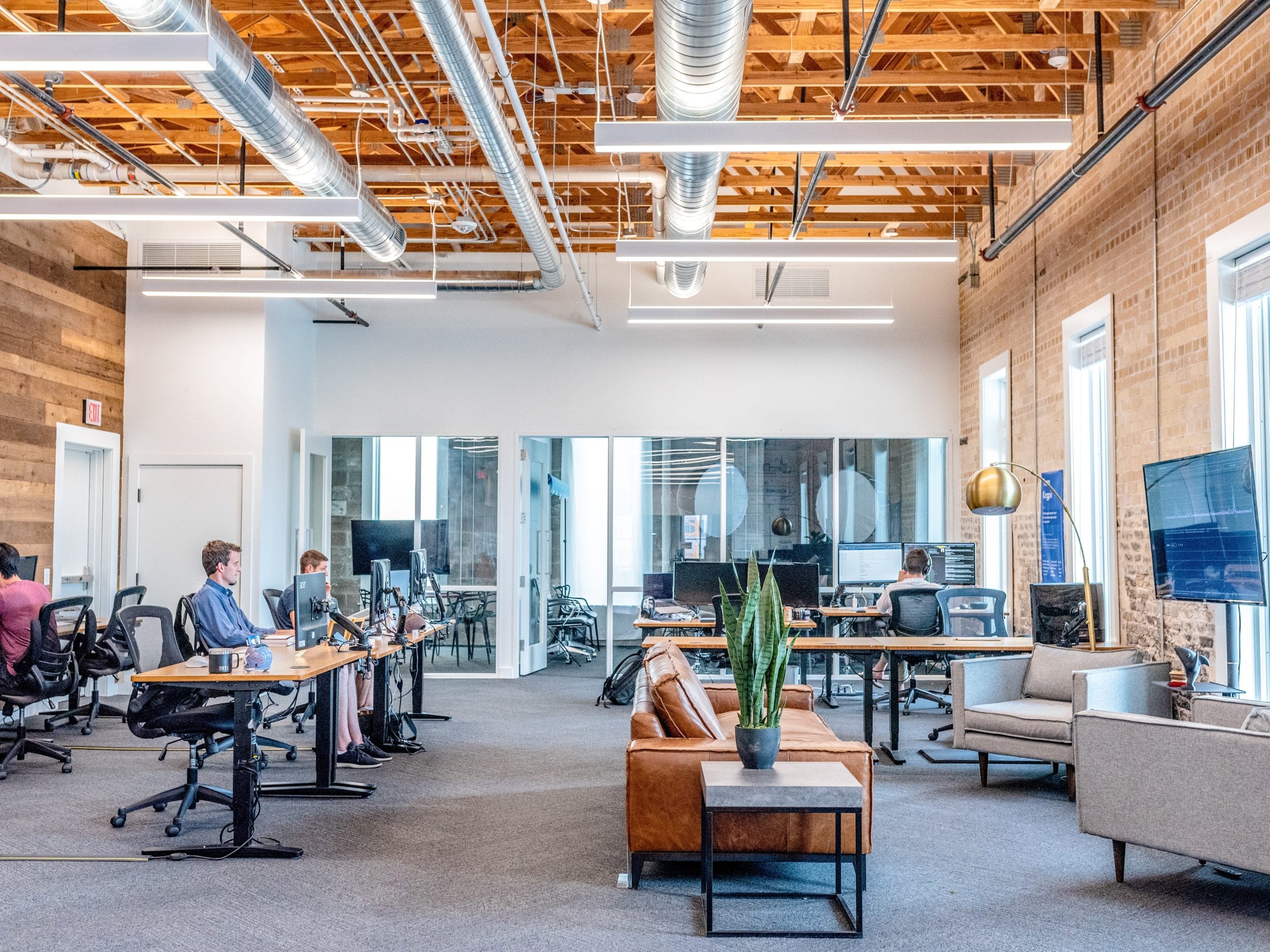Beyond COVID-19: What Will The Future of Work Look Like?
Nobody’s got a crystal ball here 🔮, but it doesn’t take Mystic Meg to predict that the world of work will experience some coronavirus after-effects.
We’ve been conducting global market research (you might’ve read the report) and chatting to our customers non-stop for weeks to understand the impacts COVID-19 is having on the workplace.
Here are six predictions we’ve uncovered for the future of work beyond COVID-19…

1 – Remote and flexible working will become the norm
Digital labour specialist Dr. Maria Mexi calls COVID-19 “a major tipping point for the digital transformation of the workplace” – and our own research concurs:
- 54% of employees want to work remotely either part- or full-time in the future
- 63% of C-Suite employees want to work remotely in some capacity
The remote working cat isn’t getting back into the bag.
Remote and flexible working have been major drivers of employee engagement for years, but despite many businesses (including behemoths like EY and PwC) embracing flexi-work, plenty of others still haven’t.
- In 2019, 83% of global employees would turn down a job that didn’t offer flexible working. And 28% value flexible working over increased holiday allowance (IWG)
- Although flexible and remote working has grown by 173% by 2005 (Global Workplace Analytics), only 62% of businesses globally had a flexible working policy in 2019 (IWG).
That’s likely to change post COVID-19, as many employees realise the benefits of flexibility and teams adapt to dispersed work. ‘We need you in the office’ isn’t likely to hold much sway, with months of work-from-home working just fine.
As remote and flexible working policies become the rule, businesses will be reluctant to make themselves the exception, and risk losing the people who’ll help the business recover from the crisis.
And long-term, that’ll be a great thing for engagement.
(Even back in 2016, Gallup found employees who work remotely at least some of their time have higher engagement scores and make more progress in their working day than employees who only work from the office).

2 – There’ll be clear winners and losers in employer brand
You’ll rarely stumble on a business that doesn’t say they care about their employees. But responses to COVID-19 have shone a light on those who walk the walk versus those who prefer lip service.
The fact is, job losses and pay reductions are sometimes unavoidable but many companies’ behaviour is leaving a sour taste in employees’ mouth. Especially when those employees are already low-income and bosses at the top are hyper-wealthy.
Like…
- Britannia Hotels allegedly sacked and evicted potentially hundreds of live-in employees from hotels across the UK – leaving many jobless and homeless.
- Virgin Atlantic – 51% owned by Richard Branson, whose net worth is around $4.2Bn USD – told employees to take eight weeks unpaid leave.
Meanwhile…
- Home Bargains are making waves for their respectful, empathetic response to employees:”Message to all our staff. Thank you for your amazing work during this unprecedented time. We want you to feel secure during this turbulent period, so have created a 30 million Coronavirus Fund to financially support you during the outbreak. This will include paying staff that need to self-isolate for up to two weeks by maintaining their pay during this period, and to support Team Members in high risk groups that need to isolate for longer periods. If staff do to need to self-isolate between now and December they will be paid two weeks’ extra salary, so they do not miss out. For more details on eligibility and how this all works, please visit The Staff Portal.”
- Proving small businesses can also stand tall for their people, LINGsCARS went viral for their super authentic (but very NSFW) letter to employees. Including from-the-heart sentences from boss Ling Valentine such as “Our contract of employment reserves the right to lay you off or impose short time working, but as I’m not a bastard we’re not doing that,” and “If anyone gets into hardship, TALK TO ME. I’m happy to consider loans or salary advances (or even gifts) to help out if you get in dire-straits.” You can read the full letter for yourself here.
Employees need support now more than ever, but many businesses are falling short.
In particular, our research shows COVID-19 has caused a rift between managers and employees. Many employees feel abandoned, finding busy managers unempathetic and hard to reach.
- 68% of employees say their manager hasn’t even asked how they’re feeling during the pandemic.
- 56% of employees say remote working has made it harder to communicate with their manager.
- 22% of employees say they’re worried about the future but afraid to voice their concerns to their manager.
That’s a major engagement issue, because crap managers deliver crap experiences. That’s why managers account for 70% of variance in employee engagement scores.
The truth is, from trigger-happy redundancies to poor manager support, many businesses are making mistakes now they’re likely to pay for long-term. And post COVID-19, when the dust settles, we’ll see clear winners and losers emerging in the employer brand stakes.
Long-term, that could well drive a redistribution of top talent which could redefine the commercial landscape too. Poor crisis response now could spell significant trouble in 12 to 24-months.

3 – Businesses will need to double-down on EX
With dispersed teams becoming the new normal, there’s a real risk of delivering a fractured, inconsistent employee experience. And when that happens, the employee-employer relationship becomes purely transactional – which drives disengagement and turnover.
- More than 3 in 4 employees who voluntarily quit their jobs in 2018 could have been retained if the employee experience had been better (WorkInstitute)
Post COVID-19, businesses will need to double-down on employee experience. It’ll be crucial to strengthen your culture across new borders and support teams who’re working together in new ways.
We wrote recently about the idea of creating moments that matter. That principle’s just as true for remote workers: create memorable virtual moments – so your remote employees have the same employee experience as anyone in-office.
See what Enboarder’s been doing to maintain our culture remotely.
Mental health support too will prove vital. Organizational psychologist Adam Grant believes some employees will face post-traumatic stress, for example, and everyone’s likely to feel a little shell-shocked.
Delivering a supportive, engaging employee experience – to everyone in your workforce, however they work with you – will be absolutely central to keeping best people onboard and productive post COVID-19.

4 – The gig economy will grow
The new workforce won’t just look like in-office employees working remotely. We might well see a seismic shift away from permanent, traditional employment altogether.
This crisis has challenged one of the major value propositions for traditional permanent employment: job security. And the gig economy was already growing massively.
- 46% of HR professionals believe at least 1/5th of their workforce will be contractors and temporary workers by 2022 (PwC)
- 60% of global employees believe few people will have stable, long-term employment in the future (PwC)
- By 2020, almost one in five workers are contingent workers (EY)
For employees who’ve been considering working for themselves, COVID-19 could be the last push they need. Especially if they’re amongst the 47% of employees who said to us they’re equally or more productive and engaged working from home.
That could be a really good thing for businesses.
Before this crisis, PwC reported 19% of organisations saw lack of agility as their biggest fear for the future. COVID-19’s done nothing if not prove that fear true – and embracing a more flexible workforce plays a huge part.
Right now though, only 34% of global businesses believe they’re positioned to tap into flexible talent.
That’ll need to change post COVID-19, as businesses assess the tools, processes and practices they use to engage effectively with contingency workers.

5 – L&D will be a major success factor
Coronavirus has thrown a lot into the air. Businesses are having to adapt fast; employees are having to collaborate in new ways, to find new ways to add value to customers.
Often that’s creating a major and unexpected skills gap. A skills gap that gets in the way of progress, creating friction for workers and driving disengagement.
- For instance, our research shows a third of Gen Z employees are frustrated by colleagues whose tech-illiteracy makes remote communication harder.
Being able to quickly identify and fill skills gaps will likely prove crucial to business recovery after COVID-19.
You’d expect the major culprits to be the digital and technology skills that power the shift to remote working, and change management skills should be vital too.
Employee adaptability – already the 6th most important business capability, PwC say – will likely be increasingly important, as businesses struggle with long-term uncertainty and need a workforce who take change in their stride.

6 – Businesses will re-evaluate the office environment
Although remote working is likely to become more prevalent, our research suggests plenty of employees will still want to work from the office, even if part-time:
- 40% of employees have realized they prefer working from the office
(No surprise really, after we’ve all been stuck at home with partners, children, relatives, flatmates or grouchy cats for weeks…)
For the people who do come into the office, there’ll likely be new questions about that environment. As workplace design expert Howard Barnes writes, COVID-19 could “completely reset our view of [workplace] real estate, and our expectations from it.”
Do we really want to work to take crushing commutes to concrete office blocks, breathing recirculated air from air conditioning units? If more people are working remotely, does a huge office even make sense anymore? Could we redistribute our offices into smaller remote working hubs?
If the composition of the workforce changes dramatically, our cities might look very different in five to ten years as office blocks get pulled down or repurposed.
To discover more insights and data into how COVID-19 is impacting the workforce, download the full State of Employee Experience Report: COVID-19 Edition.